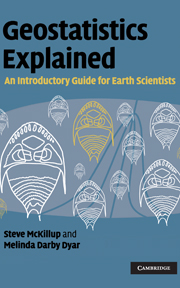Book contents
- Frontmatter
- Contents
- Preface
- 1 Introduction
- 2 “Doing science”: hypotheses, experiments and disproof
- 3 Collecting and displaying data
- 4 Introductory concepts of experimental design
- 5 Doing science responsibly and ethically
- 6 Probability helps you make a decision about your results
- 7 Working from samples: data, populations and statistics
- 8 Normal distributions: tests for comparing the means of one and two samples
- 9 Type 1 and Type 2 error, power and sample size
- 10 Single-factor analysis of variance
- 11 Multiple comparisons after ANOVA
- 12 Two-factor analysis of variance
- 13 Important assumptions of analysis of variance, transformations and a test for equality of variances
- 14 Two-factor analysis of variance without replication, and nested analysis of variance
- 15 Relationships between variables: linear correlation and linear regression
- 16 Linear regression
- 17 Non-parametric statistics
- 18 Non-parametric tests for nominal scale data
- 19 Non-parametric tests for ratio, interval or ordinal scale data
- 20 Introductory concepts of multivariate analysis
- 21 Introductory concepts of sequence analysis
- 22 Introductory concepts of spatial analysis
- 23 Choosing a test
- Appendices
- References
- Index
13 - Important assumptions of analysis of variance, transformations and a test for equality of variances
Published online by Cambridge University Press: 05 June 2012
- Frontmatter
- Contents
- Preface
- 1 Introduction
- 2 “Doing science”: hypotheses, experiments and disproof
- 3 Collecting and displaying data
- 4 Introductory concepts of experimental design
- 5 Doing science responsibly and ethically
- 6 Probability helps you make a decision about your results
- 7 Working from samples: data, populations and statistics
- 8 Normal distributions: tests for comparing the means of one and two samples
- 9 Type 1 and Type 2 error, power and sample size
- 10 Single-factor analysis of variance
- 11 Multiple comparisons after ANOVA
- 12 Two-factor analysis of variance
- 13 Important assumptions of analysis of variance, transformations and a test for equality of variances
- 14 Two-factor analysis of variance without replication, and nested analysis of variance
- 15 Relationships between variables: linear correlation and linear regression
- 16 Linear regression
- 17 Non-parametric statistics
- 18 Non-parametric tests for nominal scale data
- 19 Non-parametric tests for ratio, interval or ordinal scale data
- 20 Introductory concepts of multivariate analysis
- 21 Introductory concepts of sequence analysis
- 22 Introductory concepts of spatial analysis
- 23 Choosing a test
- Appendices
- References
- Index
Summary
Introduction
Parametric analysis of variance assumes the data are from normally distributed populations with the same variance and there is independence, both within and among treatments. If these assumptions are not met, an ANOVA may give you an unrealistic F statistic and therefore an unrealistic probability that several sample means are from the same population. Therefore it is important to know how robust ANOVA is to violations of these assumptions and what to do if they are not met, because in some cases it may be possible to transform the data to make variances more homogeneous or give distributions that are better approximations to the normal curve.
This chapter discusses the assumptions of ANOVA, followed by three frequently used transformations. Finally, there are descriptions of two tests for the homogeneity of variances.
Homogeneity of variances
The first and most important assumption is that the data for each treatment (or treatment combination in the case of two-factor and more complex ANOVA designs) are assumed to have come from populations that have the same variance. Equality of variances is called homogeneity of variances or homoscedasticity, while unequal variances show heterogeneity of variances or heteroscedasticity. Nevertheless, statisticians have found that ANOVA is relatively robust in terms of departures from homoscedasticity, and there has been considerable discussion about whether it is necessary to apply tests which assess this before doing an ANOVA, especially because these may be too sensitive when sample sizes are large, or too insensitive when sample sizes are small (e.g. Koch and Link, 2002).
- Type
- Chapter
- Information
- Geostatistics ExplainedAn Introductory Guide for Earth Scientists, pp. 166 - 177Publisher: Cambridge University PressPrint publication year: 2010



